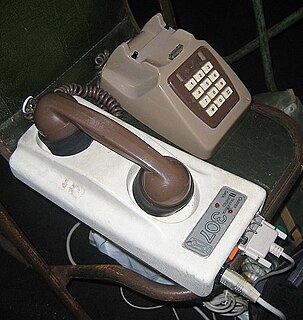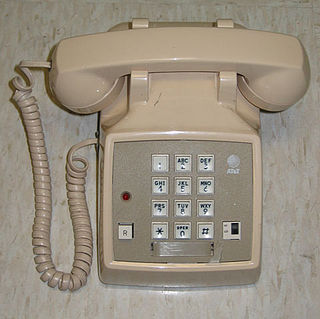Voice over Internet Protocol (VoIP), also called IP telephony, is a methodology and group of technologies for the delivery of voice communications and multimedia sessions over Internet Protocol (IP) networks, such as the Internet. The terms Internet telephony, broadband telephony, and broadband phone service specifically refer to the provisioning of communications services over the public Internet, rather than via the public switched telephone network (PSTN).
Phreaking is a slang term coined to describe the activity of a culture of people who study, experiment with, or explore telecommunication systems, such as equipment and systems connected to public telephone networks. The term phreak is a sensational spelling of the word freak with the ph- from phone, and may also refer to the use of various audio frequencies to manipulate a phone system. Phreak, phreaker, or phone phreak are names used for and by individuals who participate in phreaking.

9-1-1, also written 911, is an emergency telephone number for the North American Numbering Plan (NANP), one of eight N11 codes. Like other emergency numbers around the world, this number is intended for use in emergency circumstances only, and using it for any other purpose is a crime in certain jurisdictions.
A dialer or dialler is an electronic device that is connected to a telephone line to monitor the dialed numbers and alter them to seamlessly provide services that otherwise require lengthy National or International access codes to be dialed. A dialer automatically inserts and modifies the numbers depending on the time of day, country or area code dialed, allowing the user to subscribe to the service providers who offer the best rates. For example, a dialer could be programmed to use one service provider for international calls and another for cellular calls. This process is known as prefix insertion or least cost routing. A line powered dialer does not need any external power but instead takes the power it needs from the telephone line.

A telephone call is a connection over a telephone network between the called party and the calling party.
Call forwarding, or call diversion, is a telephony feature of some telephone switching systems which redirects a telephone call to another destination, which may be, for example, a mobile or another telephone number where the desired called party is available. Call forwarding was invented by Ernest J. Bonanno. In North America, the forwarded line usually rings once to remind the customer using call forwarding that the call is being redirected. More consistently, the forwarded line indicates its condition by stutter dial tone. Call forwarding typically can redirect incoming calls to any other domestic telephone number, but the owner of the forwarded line must pay any toll charges for forwarded calls. Call forwarding is often enabled by dialing *72 followed by the telephone number to which calls should be forwarded. Once someone answers, call forwarding is in effect. If no one answers or the line is busy, the dialing sequence must be repeated to effect call forwarding. Call forwarding is disabled by dialing *73. This feature requires a subscription from the telephone company. Also available in some areas is Remote Access to call forwarding, which permit the control over call forwarding from telephones other than the subscriber's telephone. VOIP and cable telephone systems also often allow call forwarding to be set up and directed via their web portals.
Phone fraud, or more generally communications fraud, is the use of telecommunications products or services with the intention of illegally acquiring money from, or failing to pay, a telecommunication company or its customers.
A network access server (NAS) is a single point of access to a remote resource.
ToneLoc was a popular war dialing computer program for MS-DOS written in the early to mid-1990s by two programmers known by the pseudonyms Minor Threat and Mucho Maas. The name ToneLoc was short for "Tone Locator" and was a word play on the name of the rap artist known as Tone Lōc.

A digital subscriber line (DSL) modem is a device used to connect a computer or router to a telephone line which provides the digital subscriber line service for connectivity to the Internet, which is often called DSL broadband.
Cracking a wireless network is defeating the security of a wireless local-area network. A commonly used wireless LAN is a Wi-Fi network. Wireless LANs have inherent security weaknesses from which wired networks are exempt.
Warzapping is the act of searching for remote disable features in electronics or computing devices, generally while in motion, using a portable computer or PDA.

A modem is a hardware device that converts data between transmission media so that it can be transmitted from computer to computer. The goal is to produce a signal that can be transmitted easily and decoded to reproduce the original digital data. Modems can be used with any means of transmitting analog signals from light-emitting diodes to radio. A common type of modem is one that turns the digital data of a computer into modulated electrical signal for transmission over telephone lines and demodulated by another modem at the receiver side to recover the digital data.
WiFi-Where is a tool that facilitates detecting wireless LANs using the 802.11b, 802.11a and 802.11g WLAN standards. Versions exist for the operating systems iOS and Palm OS. Originally created in June 2004 for the Palm OS by Jonathan Hays of Hazelware Software, the IP for WiFi-Where was licensed to 3Jacks Software in 2009. An iPhone version of the application was released in January 2010, but was pulled from the App Store by Apple in March 2010. As of 2010, it is available in the Jailbroken Cydia store.

H D Moore is network security expert, open source programmer, and hacker. He is the developer of the Metasploit Framework, a penetration testing software suite, and the founder of the Metasploit Project.
An automatic dialer is an electronic device or software that automatically dials telephone numbers. Once the call has been answered, the autodialer either plays a recorded message or connects the call to a live person.












